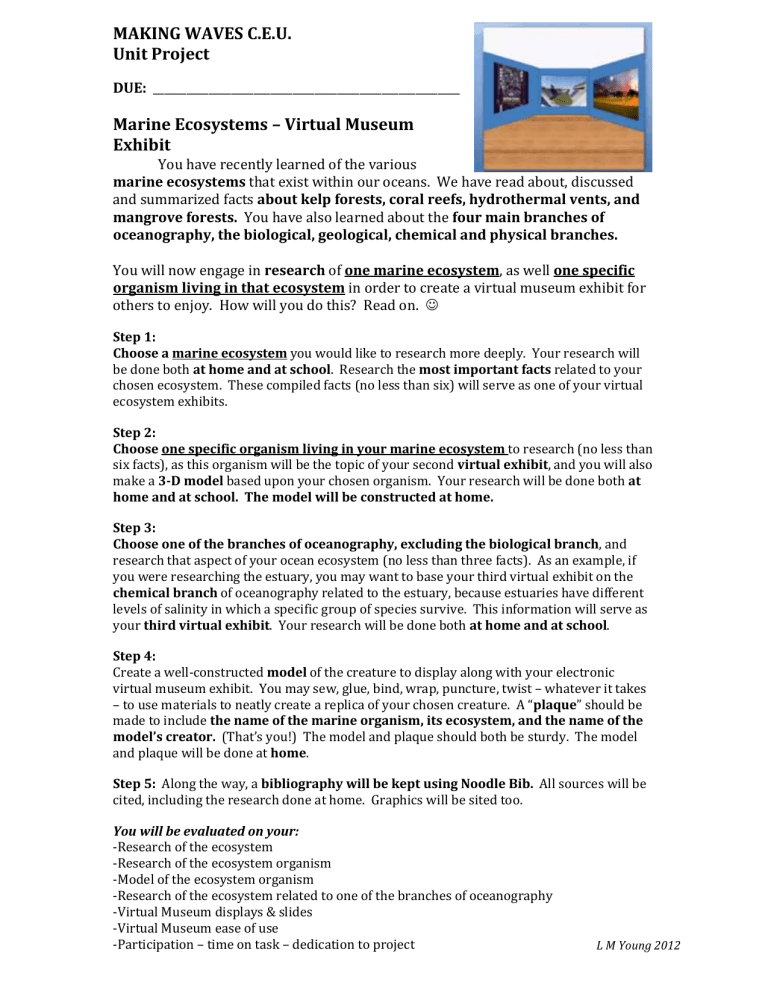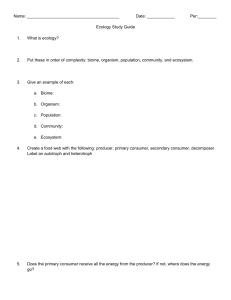MAKING WAVES CEU Marine Ecosystems – Virtual Museum Exhibit

MAKING WAVES C.E.U.
Unit Project
DUE: _______________________________________________________
Marine Ecosystems – Virtual Museum
Exhibit
You have recently learned of the various
marine ecosystems that exist within our oceans. We have read about, discussed and summarized facts about kelp forests, coral reefs, hydrothermal vents, and
mangrove forests. You have also learned about the four main branches of oceanography, the biological, geological, chemical and physical branches.
You will now engage in research of one marine ecosystem, as well one specific
organism living in that ecosystem in order to create a virtual museum exhibit for others to enjoy. How will you do this? Read on.
Step 1:
Choose a marine ecosystem you would like to research more deeply. Your research will be done both at home and at school. Research the most important facts related to your chosen ecosystem. These compiled facts (no less than six) will serve as one of your virtual ecosystem exhibits.
Step 2:
Choose one specific organism living in your marine ecosystem to research (no less than six facts), as this organism will be the topic of your second virtual exhibit, and you will also make a 3-D model based upon your chosen organism. Your research will be done both at
home and at school. The model will be constructed at home.
Step 3:
Choose one of the branches of oceanography, excluding the biological branch, and research that aspect of your ocean ecosystem (no less than three facts). As an example, if you were researching the estuary, you may want to base your third virtual exhibit on the
chemical branch of oceanography related to the estuary, because estuaries have different levels of salinity in which a specific group of species survive. This information will serve as your third virtual exhibit. Your research will be done both at home and at school.
Step 4:
Create a well-constructed model of the creature to display along with your electronic virtual museum exhibit. You may sew, glue, bind, wrap, puncture, twist – whatever it takes
– to use materials to neatly create a replica of your chosen creature. A “plaque” should be made to include the name of the marine organism, its ecosystem, and the name of the
model’s creator. (That’s you!) The model and plaque should both be sturdy. The model and plaque will be done at home.
Step 5: Along the way, a bibliography will be kept using Noodle Bib. All sources will be cited, including the research done at home. Graphics will be sited too.
You will be evaluated on your:
-Research of the ecosystem
-Research of the ecosystem organism
-Model of the ecosystem organism
-Research of the ecosystem related to one of the branches of oceanography
-Virtual Museum displays & slides
-Virtual Museum ease of use
-Participation – time on task – dedication to project L M Young 2012
Facts reflect solid research & are fluently written
Ocean Branch facts clearly connect with ecosystem
Bibliography reflects well kept & multiple sources
Information & photos on slides are effectively presented
Navigation is easy to use to observe the entire exhibit
Model reflects creativity, research and is well constructed
Effective use of
CEU class time throughout the project
MAKING WAVES C.E.U.
Marine Ecosystems – Virtual Museum Exhibit
Unit Project
Checklist & Rubric
Name: _____________________________________________________
Checklist:
Six ecosystem facts
Six organism facts
Three oceanography branch facts related to the ecosystem
Three main exhibit photos (linked & credited)
At least three virtual museum facts slides
A complete bibliography
All slides linked for navigation
Model of organism
A plaque for model
Rubric:
Exceeds Expectation Meets Expectation Needs Improvement Unsatisfactory
3
3
3
3
3
3
3
2
2
2
2
2
2
2
1
1
1
1
1
1
1
0
0
0
0
0
0
0
L M Young 2012







